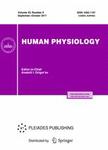版权所有:内蒙古大学图书馆 技术提供:维普资讯• 智图
内蒙古自治区呼和浩特市赛罕区大学西街235号 邮编: 010021

作者机构:National Research Tomsk State University Tomsk Russian Federation National Research Tomsk Polytechnic University Tomsk Russian Federation Scientific Research Institute of Neurosciences and Medicine Novosibirsk Russian Federation Tomsk State University of Control Systems and Radioelectronics Tomsk Russian Federation
出 版 物:《Human Physiology》 (Hum. Physiol.)
年 卷 期:2022年第48卷第4期
页 面:355-369页
学科分类:0710[理学-生物学] 1002[医学-临床医学] 1001[医学-基础医学(可授医学、理学学位)] 07[理学] 071003[理学-生理学]
基 金:Tomsk State University TSU
主 题:balance biofeedback coordination intermuscular interactions movement regulation muscular-articular feeling
摘 要:Abstract: The aim of this study was to study the physiological features of the formation of balance and coordination abilities based on training with biofeedback for various parameters. The study involved 60 girls aged 18–20 years, not engaged in sports and included in the main medical group (health group 1). The difference in the results of testing carried out for the selection of participants in the three groups was insignificant. Twenty girls were trained according to a program that included a set of exercises to develop the sensitivity of the vestibular analyzer and proprioceptive sensitivity. Twenty girls were trained on a Stabilan 01-2 computer stabiloanalyzer using feedback for the “projection position of the center of gravity parameter. The remaining 20 subjects studied on a HUBER apparatus using feedback for the “applied efforts parameter. Classes were held 3 times a week for a month, 12 workouts in total. Before the start of the training course, as well as after it, the girls underwent comprehensive testing using the methods of electromyography, stabilometry, EEG, and dynamometry on the HUBER apparatus. It was found that training with biofeedback contributes to the accelerated formation of the skill of maintaining balance, allows faster development of proprioceptive sensitivity, the ability to differentiate applied efforts without the participation of a visual analyzer, as well as to improve intermuscular coordination and muscle memory. A characteristic feature of the bioelectrical activity of the lower leg muscles while maintaining static balance after training with biofeedback for the “projection position of the center of gravity parameter is an activation of the lower leg muscles in the static mode (simultaneous activation of antagonist muscles with commensurate indicators of bioelectrical activity). At the same time, after training with biofeedback according to the “applied efforts in the position of seeking dynamic balance parameter, the lower leg